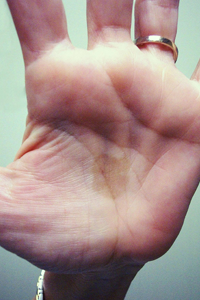- Clinical Technology
- Adult Immunization
- Hepatology
- Pediatric Immunization
- Screening
- Psychiatry
- Allergy
- Women's Health
- Cardiology
- Pediatrics
- Dermatology
- Endocrinology
- Pain Management
- Gastroenterology
- Infectious Disease
- Obesity Medicine
- Rheumatology
- Nephrology
- Neurology
- Pulmonology
Discoloration on Palm That Won't Wash Off
A 42-year-old homemaker noticed a discoloration on her palm. There were no symptoms, but she was greatly perturbed by her inability to wash this “dirt” off her skin . . .

A 42-year-old homemaker noticed a discoloration on her palm. There were no symptoms, but she was greatly perturbed by her inability to wash this “dirt” off her skin with soap and water, as well as a slow but definite expansion of the spot in question. At this point, she sought dermatology consultation. The patient was in excellent health, took no medications, and had a negative family history for malignant melanoma. Despite being an avid gardener, especially at her Galveston beach house, she denied a history of trauma to the affected area. The most likely diagnosis is:
A. Resolving hematoma
B. Tinea nigra palmaris
C. Acral lentiginous malignant melanoma
D. Insect bite
Answer: B
Discussion
This patient’s history is classic for tinea nigra palmaris: the appearance of an asymptomatic, variably pigmented and sharply marginated macule on the palm. On rare occasions, this infection can appear on the sole, and would then be called tinea nigra plantaris. As both names suggest, this disorder is caused by a superficial fungal infection (“tinea”) with the ubiquitous soil saprophyte Hortaea werneckii. (This fungus was previously known as Exophiala werneckii). Most all cases of this disease occur in tropical or subtropical climates, and therefore it is quite rare in the northern United States and Europe. By contrast, tinea nigra palmaris is common throughout Latin America, India and Polynesia.1 In addition, most cases are seen in individuals who have close contact with grasses or plants (eg, gardeners, farmers, horticulture workers). A final predisposing factor seems to be exposure to high salinity. The latter may be important because the causative organism is halophilic and thrives in hypersaline environments.2 In this particular case, the patient had repeated and prolonged contact with plants in a salty, seaside environment. Interestingly, tinea nigra palmaris occurs almost equally in children and adults.3
The most important clinical significance attached to this relatively benign disorder is that it can be mistaken by patients and misidentified by health care providers as a nevus or malignant melanoma. Acral melanomas rarely occur on the palm, but more commonly appear on the distal phalanx, particularly on the skin near the nail plate. While this fungus can cause a systemic infection,4 this would be considered highly exceptional.
The diagnosis is very easy to make. Direct potassium hydroxide examinations of skin scrapings will reveal abundant short, thick, and tortuous light brown hyphae. No special stains are required. Colonies of this fungus will grow on standard fungal agar in 5 to 8 days. Molecular diagnostics (polymerase chain reaction) exist, but are virtually never required to establish the correct diagnosis once it is suspected.
Treatment is also very easy. Two-week application of salicylic acid (Whitfield’s ointment) is generally successful. Alternatively, several weeks of twice-daily topical application of almost any azole or allylamine antifungal will also lead to prompt resolution.1 Twice-daily application of ciclopirox olamine gel 0.77% for only 2 days has also proved effective.5 Relapse rate is low, and recurrence is unexpected.
References1. Bonifaz A, Badali H, de Hoog GS, et al. Tinea nigra by Hortaea werneckii: a report of 22 cases from Mexico. Stud Mycol. 2008;61:77-82.
2. Plemenitas A, Vaupotic T, Lenasssi M, et al. Adaptation of extremely halotolerant black yeast Hortaea werneckii to increased osmolarity: a molecular perspective at a glance. Stud Mycol. 2008;61:67-75.
3. Pegas JR, Criado PR, Lucena SK, de Oliveira MA. Tinea nigra: report of two cases in infants. Pediatr Dermatol. 2003;20:315-317.
4. Ng KP, Soo-Hoo TS, Na SL, et al. The mycological and molecular study of Hortaea werneckii isolated from blood and splenic abscess. Mycopathologia. 2005;159:495-500.
5. Rosen T, Lingappan A. Rapid treatment of tinea nigra palmaris with ciclopirox olamine gel. Skinmed. 2006;5:201-203.
